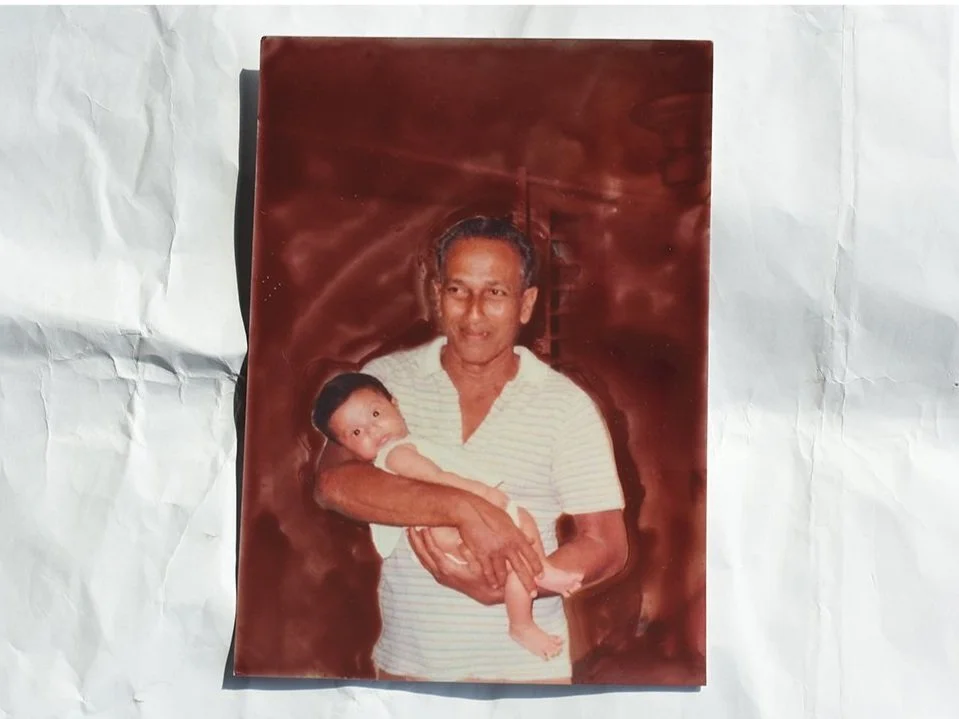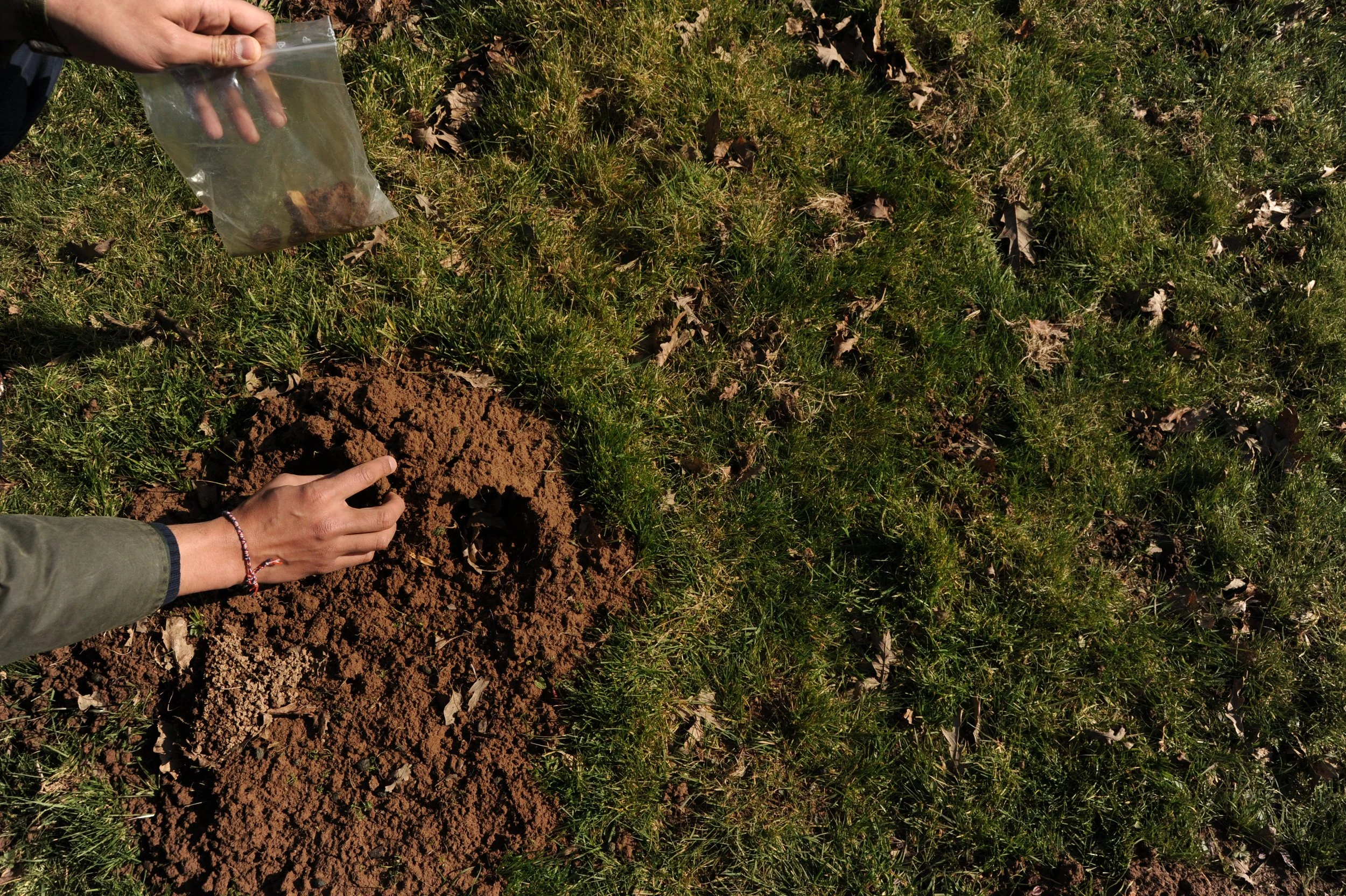on MIGRATORY ART and a MIGRATORY STUDIO
Notes on the road. Vienna / London / Delhi / Colombo, ongoing.
If you had to leave this instant, uncertain of return, what would you take with you?
In September 1989, during the early years of war in Sri Lanka, my mother and I left the country with just two suitcases. I was five. I can no longer recall what was packed inside them - but I remember the feeling that we had all we needed. That memory, more than the objects themselves, stayed with me. In it lay the beginning of a search - to find a language, a form, for what departure feels like.
This essential need for my own practice emerged from that early feeling, not only as a physical departure but as a psychological and emotional state. I have lived most of my life in flux. Even when I am still, I feel as though I am moving. Migration, for me, is no longer just an event; it has become a way of being. I began to think about how this condition - this necessity of movement, of letting go, of carrying only the essential - could be integrated into my practice? What kind of art survives the journey? What can be made when nothing can be taken for granted - not space, not permanence, not even the materials one uses?
Migratory Art became a framework. It is art created by migrants, but also art that migrates. Art made in collaboration, outside the comfort zone of my own knowledge, in temporary studios and borrowed spaces. It is about adaptability and survival, about shedding what is unnecessary in order to find clarity. Some of this work fits into hand luggage - literally. Other parts carry stories, memory, or emotion. But always, it carries the spirit of departure and the quiet hope of arrival. My studio is wherever I find myself. And my practice, like myself, is always in motion. Migration, in this context, is not merely a geopolitical condition, but an emotional and epistemological one. The practice mirrors the migratory patterns of animals, people, data, and materials - foregrounding the instability of belonging in a world increasingly defined by precarity and adaptation. It resists stasis. Instead, it proposes an art that is portable, collaborative, and mutable - art that can be folded, reassembled, or carried in a suitcase.
The Migratory Studio becomes a model for working beyond fixed sites - learning from and sharing with others, making across disciplines, and embracing the unfamiliar, the uncomfortable. It is a porous space of exchange and interdependence, where creation emerges not in isolation but through contact and collaboration. At its core, Migratory Art distills a question of survival: what do we choose to preserve when all else must be left behind? What fragments do we carry to reconstruct self and story in a new place?
FOR A FIFTY MILLION YEARS, Raki Nikahetiya, 2023, supported by DMG.
on REGENERATION AND (LAND) ART
What does it mean to make art with the land, rather than on it?
This question lies at the heart of the sā Ladakh Biennale, where the practice of Land Art is undergoing a quiet but radical transformation. In this high-altitude desert - where the fragility of ecosystems is felt daily and resilience is woven into the fabric of cultural life—artists are asked not to intervene, but to enter into relationship. It is here that Regenerative Art finds fertile ground: not as a movement of aesthetics, but as a living methodology for renewal.
Regenerative Art, as it unfolds in Ladakh, challenges the legacy of extraction—in both environmental and cultural terms. It calls for deep-time thinking, where creative gestures are made in conversation with the long arc of ecological and social consequence. This is particularly resonant in a region where water moves in centuries, mountains bear witness to generations, and stories are held in the sediment of the land itself. Within the biennale, artists are invited to work with life-cycle awareness—selecting local, biodegradable, or salvaged materials that reflect the land’s own capacity for transformation. Earth, wool, glacial silt, ancestral pigments: each material carries not only texture but memory. Here, impermanence is not a limitation, but a principle of design—reminding us that regeneration is less about what is preserved, and more about what is passed on. Through interdisciplinary practice, the biennale becomes a commons where artists, scientists, farmers, monks, and youth converge—each offering distinct ways of seeing and sensing the world. Together, they map interdependencies, surface forgotten knowledge, and build systems-based responses to the ecological questions of our time. Unlike narratives of despair that often dominate climate discourse, this biennale is grounded in climate optimism. Not optimism as denial, but as a rigorous, creative stance. Artworks become propositions for collective action: seed-saving archives, listening stations for melting glaciers, nomadic classrooms, and micro-ecosystems. These are not spectacles—they are blueprints for how to live otherwise. A next-generation focus is interwoven throughout. Youth are not recipients of knowledge, but active agents in shaping it. Regenerative pedagogy becomes both a tool and a philosophy—fostering ecological literacy and cultural continuity through hands-on participation and intergenerational dialogue.
The biennale’s community-driven ethos ensures that Ladakhi voices remain central, while transboundary collaboration allows for a rich exchange of practices and perspectives across cultures. What emerges is a network of solidarity—one that values rootedness over representation, reciprocity over replication. Ultimately, Regenerative Land Art at the sa Ladakh Biennale is not measured by permanence or spectacle, but by process and potential. It is art that listens, responds, and reimagines. It is art as stewardship. It is art as seed.
on MATERIAL and (POST) MEMORY
Calcutta / Delhi / Colombo, ongoing
Zardozi and Aari embroidery. Silk, velvet, and cotton. These are the materials I return to, again and again. There is something ancestral in them - echoes of the garments my forebears once wore, in ceremonies, in everyday rituals, in lives now slipping beyond the reach of record. I work with Reyas Ali since 2020 (pictured above, to my left), his wife, and his Zardozi and Aari embroidery team in Calcutta (not all pictured) - Kutub Udink, Yousuf Mulla, Imtiaz Alam, Alim Khan, Najim Udin, Rukunuddin Mundul, and Raja Sheik - where every stitch carries a memory.
I’ve been slowly gathering what remains - ceremonial heirlooms, worn fabrics, fragments of formal dress. But time, like the humid air of the hills, has not been kind. Mould, decay, discolouration: these textiles carry the burden of forgetting. Still, some stories linger in the bodies of elders, in gestures, smells, and the repetition of domestic rituals.
In this search for identity, I’m not looking for a neat lineage or uninterrupted chronology. I’m drawn instead to the gaps. To what is half-remembered, emotionally precise but factually vague. I seek out atmospheres - fleeting sensations that bind me to place, to people, to some sense of home. I remember the leeches after the rain. The tropical air, heavy and fragrant. My cousins playing barefoot. The porch where my great-uncles told their stories. The dense comfort of the forest. The scent of cannonball blossoms, the glow of petrol lamps. The warmth and taste of dalli-kussiya prepared over coconut-wood fires by both my grandmothers. That, too, is knowledge. That, too, is inheritance.
I return to these materials not out of nostalgia, but because they anchor me. They allow me to stitch together a sense of belonging that is layered, nonlinear, and partly imagined. Somewhere in the deep green of the jungle, up on a mountain near the equator - I trace the threads of a home I carry within me.
on IDENTITY
New Delhi / Colombo / Vienna, 2021
What are our earliest memories? Who shaped us? And who have we become in remembering?
One of my oldest memories is a black Sri Lankan Sanni Yakuma mask. Sanni masks are used by shamans for tovils (exorcism rituals), to play the role of sanni (disease) demons. There are 18 different masks but one of them I remember in particular. When I was four or five I used to wake up for weeks shaken by nightmares. As this continued my grandfather, who believed in the old ways asked for a shaman. The day for the ritual arrived, we both marched in silence through the darkness of the night to a shed on his land. The narrow path was illuminated by the light trails of fireflies, stars piercing through the crowns of coconut trees and the dim light of our petrol lamp. The door to the shed opened and the shaman welcomed me only. The air was heavy, warm and smelled of incense. The walls were drenched in flickering ochre red from the light of small coconut oil lamps. He was wearing the sanni mask and looked gruesome as he started practicing a dance. He sang prayers in Sinhala but I didn't understand him. He was in a trance. And so was I - watching his movements carve through the thick air, gestures both foreign and familiar. Time collapsed. The ritual ended as suddenly as it began. My grandfather and I walked back through the same path - silent, under the same fireflies and trees- but something had shifted. I didn’t fully understand what had taken place, but slowly, almost imperceptibly, I realised: the nightmares had stopped. The fear was gone. And in its place, a memory remained - vivid, unresolved, but somehow whole.
This moment, both obscure and formative, continues to inform my practice - a confluence of embodied memory, cultural ritual, and the aesthetics of displacement. In a broader sense, my work emerges from an engagement with postmemory: the inherited, often fragmentary recollections of diasporic experience. I began archiving old family photographs—personal relics sourced from relatives, from boxes, from memory itself. These images predate my migration to Europe and offer glimpses into a past that feels simultaneously intimate and inaccessible.
Painting became a method of activating these archives - not to reproduce them, but to engage with the emotional knowledge embedded within them. Each portrait recalled a story, a gesture, or a sensory detail: moments filtered through the distortions of nostalgia, cultural longing, and the distance of time. In revisiting them, I found that memory operated not linearly but associatively. The war in Sri Lanka, while politically and historically traumatic, exists in my child-mind as a site of wonder and myth. I associate it with jungle paths, familial rituals, and the exoticism I projected onto my own past as an immigrant negotiating a fragmented sense of identity.
The medium then shifted - from digital painting to embroidery. I began translating these painted recollections into hand-embroidered silk portraits, drawing upon craft traditions historically used in Sri Lanka to denote lineage, belonging, and sacred knowledge. In doing so, the works traverse media, geographies, and temporalities: from the analogue to the digital, from private memory to material inscription. The embroidered portraits function as contemporary reliquaries - aide-mémoires for a life suspended between locations, shaped by both lived experience and imagined return. They are acts of preservation, but also of transformation. Memory, like thread, is pulled taut - looped, knotted, embellished, and sometimes severed. These works do not claim to offer historical truth. Rather, they offer a form of personal myth-making: a way of tracing identity through material, through memory, and through the ritualised act of making.
In stitching together these memories - partial, poetic, and politically charged - I am also attempting maybe to bring together fragments of myself. Identity, in this practice, is not fixed or singular; it is layered, porous, and migratory, shaped by inherited recollections as much as lived experience. Each thread, each mark, seems to becomes a trace of who I was, who I am, and who I imagine myself to be. Through the interplay of memory, ritual, and craft, I attempt to trace the contours of a self suspended between worlds, a self constantly negotiating the spaces between origin and arrival, absence and presence, past and present. My art does not resolve these tensions, but inhabits them - a practice of remembering, of becoming, and of belonging, even when the places that once defined me no longer exist in the same form.
Related work: A SIMPLER LIFE, ANOTHER LIFE and MIGRANT MEMORY
on INTERDISCIPLINARY PHOTOGRAPHY
London / Delhi / Colombo, 2017, ongoing
What do we see when we look at a photograph? What, in fact, are we seeing - a moment, a memory, an illusion of permanence?
Susan Sontag once wrote: “Photographs are a way of imprisoning reality. One can’t possess reality, one can possess images. One can’t possess the present but one can possess the past.” Photography, then, becomes a paradoxical gesture - a form of possession born of absence. A mechanism for proving existence, for anchoring the fleeting in the material, for constructing narrative in the face of loss.
My practice has long revolved around photography - not merely as a medium, but as a conceptual entry point. I began with analogue cameras and the slow, deliberate rituals they required. The process itself was formative: waiting, composing, trusting the unseen chemistry of light and time. With the shift to digital, photography became more accessible, more immediate, more mutable - but no less powerful as a means of apprehending the world. For me, the photograph has always been a tool of making rather than simply recording. The ‘right’ image was never about perfection - it was about presence, discovery, and control in a world that often felt ungraspable.
In recent years, however, I’ve begun to question photography’s limits. What happens when an image is no longer the end point, but the beginning of a broader material or conceptual process? Can a photograph morph - into performance, sculpture, installation, sound, or poetry? Could it function as the foundation for land art or algorithmic code? Might it trigger sensory experiences that exceed the visual: textures, smells, vibrations, weight? What I understand as Interdisciplinary Photography emerges from this inquiry. It is not a genre, but a methodology - one in which the photographic image initiates a dialogue across disciplines, materials, technologies, and epistemologies. Here, photography becomes a site of convergence. The camera becomes less a witness and more a collaborator, initiating unpredictable outcomes across different fields of knowledge. This approach challenges photography’s longstanding association with documentary objectivity. It shifts the practice from one of capturing the real to one of reimagining it. Interdisciplinary photography collapses traditional hierarchies between mediums and makes space for hybrid forms - where image becomes artifact, data becomes textile, memory becomes material, and form is in constant flux.
This is not the end of photography, but the emergence of a new photographic consciousness. One that moves beyond representation into research, experimentation, and transformation. It reflects the wider condition of our time: where identities, technologies, and narratives are plural, layered, and porous. In this expanded field, the photograph becomes both subject and agent. It travels - through media, through disciplines, through memory and metaphor. It resists closure. It invites collaboration. And it insists that to see is no longer enough. We must also sense, translate, deconstruct, and remake. This is where I begin.
Related work: V.I.R.A.L2021, V.I.R.A.L2022, A SIMPLER LIFE and AN ULTRASTRUCTURE OF BRITAIN
on PHOTOGRAPHIC NEGATIVES
London / Delhi / Colombo, 2015, ongoing
A photographic negative is not merely an inversion -it is a quiet subversion of perception. Dark becomes light, light becomes dark. In colour negatives, blue turns to yellow, green to magenta, red to cyan. The visible world is reorganised into its chromatic opposite: an alternate spectrum, a counter-reality.
In my practice, particularly in the POSSIBILITIES and IN-CARNATIONS series, I employ the negative as both material and metaphor. Not as a precursor to the ‘final’ image, but as a conceptual tool- a way of seeing otherwise. By dislocating colour and contrast, I attempt to unsettle the viewer’s habitual relationship to the visible and draw attention to the constructed nature of perception itself.
In an era defined by visual saturation—where thousands of images are consumed and discarded daily—the negative serves as a counterpoint. It resists immediacy. It asks for a pause. It demands a kind of un-seeing, or re-seeing, that confronts how we categorise what is familiar. The photograph, once assumed to represent a stable reality, becomes a site of transformation - where absence becomes presence, and the unseen emerges from what we thought we understood.
The negative also carries with it a sense of latency. It is an image in waiting, a blueprint not yet realised. In this sense, it embodies potential: it gestures toward what could be, rather than what is. And yet, it is already fully formed - a paradox of simultaneity.
Inverting the image becomes a strategy for interrogating not just form, but cognition. What do we filter out in our everyday seeing? What becomes background, what becomes noise? What registers, and why? The photographic negative doesn’t offer answers - it disturbs the frame through which we view the world, inviting multiple interpretations and alternate readings of space, subject, and reality.
Ultimately, whether in positive or negative, image or afterimage, my interest lies in how perception shapes meaning - how we interpret, filter, and often overlook what is present before us. If every image carries both what is seen and what is suppressed, then how might shifting our perspective reveal what we’ve never learned to notice?
Related work: IN CARNATIONS and POSSIBILITIES






